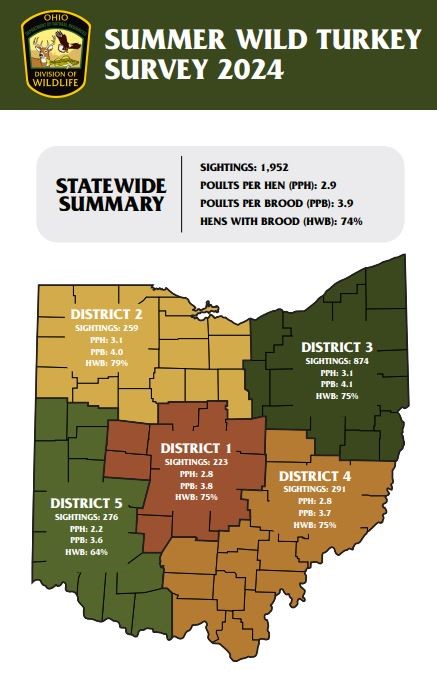Ohio’s Wild Turkey Population on the Rise
The Ohio Department of Natural Resources Division of Wildlife recently announced promising news for the state's wild turkey population, reporting a slight increase in the 2024 wild turkey poult index. With an average of 2.9 poults per hen, this marks the fourth consecutive year of above-average or slightly above-average brood surveys—a positive trend that highlights Ohio’s ongoing turkey population growth.
The poult index is a critical measure of turkey reproductive success, based on public reports collected in July and August. These brood surveys offer insight into nest success and poult survival, essential factors in understanding current turkey populations and setting future harvest regulations.
A Trend of Growth
Ohio’s turkey populations have seen robust nest productivity in recent years, as demonstrated by improved poult index trends: an average of 2.8 poults per hen in 2023, 3.0 in 2022 and 3.1 in 2021. This sustained success has nudged Ohio’s 10-year average upward from 2.7 to 2.8 poults per hen.
While regional variations in production were noted—northeast and northwest Ohio recorded 3.1 poults per hen, southeast and central Ohio saw 2.8 and southwest Ohio measured 2.2—the overall trend is positive, particularly in the eastern and southern counties where turkey populations tend to thrive. In 2024, these results were informed by 1,952 public survey responses, reinforcing the role of citizen scientists in wildlife management.

“Ohio’s statewide index of poults per hen was slightly above average for the 4th summer in a row in 2024, which is very encouraging,” said Mark Wiley, ODNR wildlife biologist and NWTF National Wild Turkey Technical Committee representative. “These strong poult classes have boosted Ohio’s spring permit success rates in recent years. It appears success rates will remain high through 2026 when the 2024 class of poults matures into 2-year-old gobblers.”
NWTF's Ongoing Contribution
The National Wild Turkey Federation has been a dedicated partner in fostering the habitat needed for turkey populations to flourish across the Buckeye State. Recognizing that habitat quality is essential for thriving wild turkey populations, the NWTF has focused on improving both public and private lands.
The Ohio NWTF State Chapter is currently engaged in six conservation projects across the state for 2024, targeting key areas such as early successional habitat restoration, forest health and restoration, grassland and riparian restoration, water health and hunter access. These efforts will positively impact over 1,600 acres of habitat, making a lasting impact on the state's wild turkey population. New projects for 2025 will be announced soon.
In addition to these habitat improvement projects, the Ohio NWTF State Chapter contributed $50,000 in 2023 to support the first broad-scale study of hen survival in Ohio in nearly two decades. Conducted by the Ohio DNR and Ohio State University, this research aims to help wildlife managers understand how turkey survival, harvest rates and reproduction have evolved over the last 17 years, providing invaluable data for future conservation efforts.
“It is exciting to see that Ohio and many of our Midwestern states have seen increases in poult per hen estimates derived from the citizen-science brood surveys,” said Ryan Boyer, NWTF district biologist for Ohio, Indiana and Michigan. “These long-term datasets allow biologists and our state agencies to assess annual variation and long-term trends in production, and it’s really nice to see the upward trends. These data along with the data being collected through the research project at the Ohio State University in partnership with the Ohio Division of Wildlife and the NWTF Ohio State Chapter, will help provide additional data on the important breeding season vital rates such as nest success and hen survival to help us better understand the more complete picture of what is taking place in Ohio. Coupled with the support of ongoing research, the NWTF and our state chapter places a strong emphasis on us supporting sound habitat projects designed to improve habitat for wild turkeys, especially during the breeding season.”
Looking Forward
Ohio’s wild turkey restoration is a remarkable conservation success story. After their population was decimated around 1904, the Ohio DNR launched reintroduction efforts in the 1950s. These initiatives resulted in rapid population growth, and by 1999, wild turkeys were present in all 88 counties.
The Ohio NWTF State Chapter's ongoing projects, partnerships and support for research are helping ensure a bright future for the state's wild turkey population. With above-average brood surveys for four consecutive years and significant habitat improvement efforts underway, Ohio is well-positioned to continue its legacy of turkey conservation.
Ohio’s fall wild turkey hunting season runs from October 1 to October 27, with a bag limit of one turkey of either sex. Hunters are required to possess a valid Ohio hunting license and a fall turkey permit. Successful hunters must complete the game check process.
For more information on Ohio’s 2024 wild turkey hatch results, visit Ohio DNR's website. For details on Ohio’s fall turkey season, consult the 2024-25 Hunting and Trapping Regulations.
